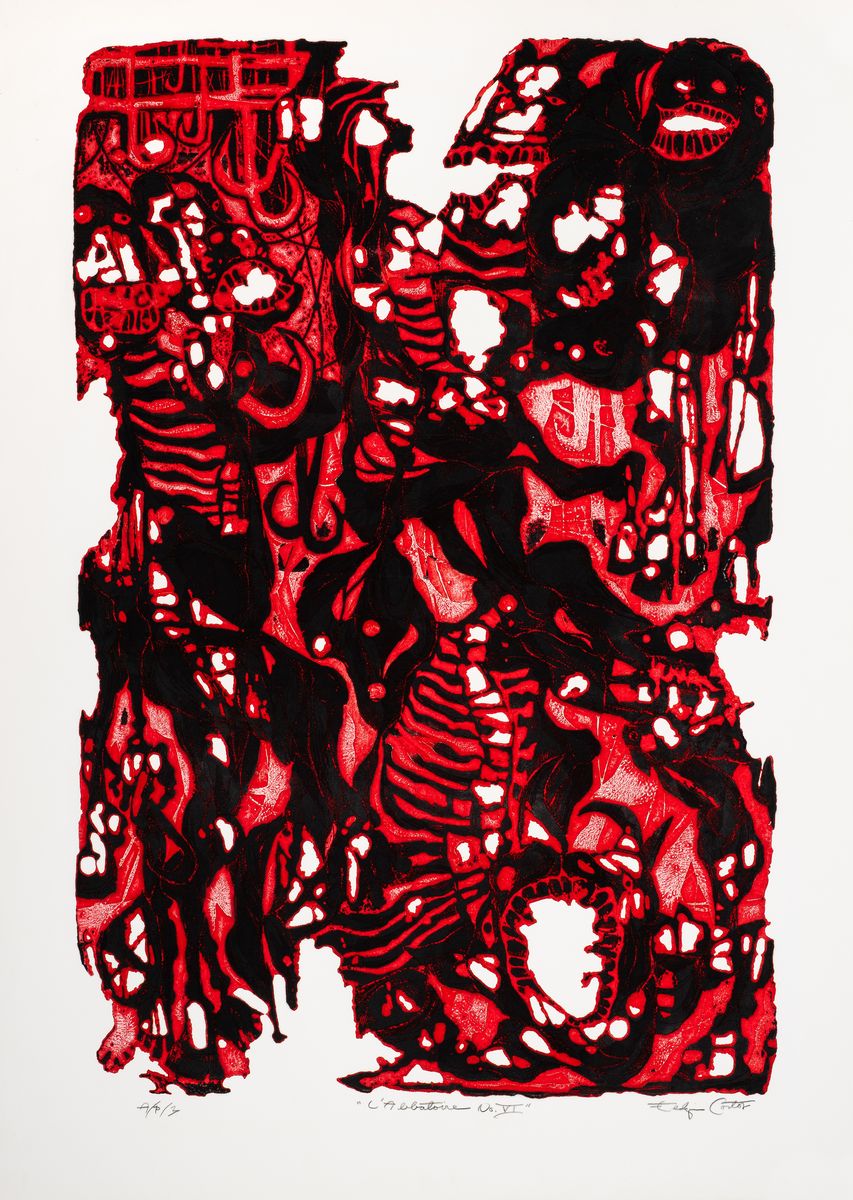
L'Abbatoire VI
Artist:
Eldzier Cortor
(American, 1916 - 2015)
Place made:United States, North and Central America
Date: c. 1955, printed 2000
Medium: Intaglio relief print on paper
Dimensions:
print: 35 1/2 × 21 1/4 in. (90.2 × 54 cm)
paper: 40 3/4 × 29 1/8 in. (103.5 × 74 cm)
mat: 44 × 32 in. (111.8 × 81.3 cm)
Credit Line: Gift of Eldzier Cortor in memory of Sophia R. Cortor
Object number: 2013.33.1
Signed: Signed lower right
Markings: Lower left - A/P/3
Copyright: © Eldzier Cortor / Artists Rights Society (ARS), New York
Inscribed: "L'Abbatoire VI"
Label Text
Taking its title from the French word for “slaughterhouse,” Eldzier Cortor’s L’Abbatoire series evokes the raw and the grotesque through blood-red hues and hellish imagery. While abstracted, representational elements such as metal hooks, chains, and rib cages are recognizable in some of the works.
An African American artist who studied at the School of the Art Institute of Chicago, Cortor traveled to Haiti, Jamaica, and Cuba from 1949 to 1951 on a Guggenheim Fellowship. This trip exposed the artist to black culture and folk art that was largely untouched by outside influences. Within this context, the L’Abbatoire prints become a metaphor for the brutal and repressive Haitian regime of François “Papa Doc” Duvalier and the dreaded paramilitary unit called the Tonton Macoutes (“Uncle Gunnysack,” the name of a mythological Haitian boogeyman), who tortured, maimed, and killed anyone perceived to oppose the dictator.
(Lana Meador, group label 2018)
Taking its title from the French word for “slaughterhouse,” Cortor’s L’Abbatoire series is comprised of prints that reference the raw and grotesque through blood-red hues and hellish imagery. While abstracted, representational elements such as metal hooks, chains, and rib cages can still be identified in the work.
Cortor, an African American artist who studied at the School of the Art Institute of Chicago, traveled to Haiti, Jamaica, and Cuba on a Guggenheim Fellowship from 1949 to 1951. This trip exposed the artist to black culture and folk art that was largely untouched by outside influences. With this context, the prints of L’Abbatoire become a metaphor for the brutal and repressive Haitian regime of François “Papa Doc” Duvalier and the dreaded paramilitary Tontons Macoutes, who tortured, maimed, and killed anyone perceived to oppose him. Although the figures are abstract, Cortor’s inclusion of body fragments creates a portrait of Duvalier’s depravity as well as of the repressed Haitian people.
(Anna Stothart, 2016)
An African American artist who studied at the School of the Art Institute of Chicago, Cortor traveled to Haiti, Jamaica, and Cuba from 1949 to 1951 on a Guggenheim Fellowship. This trip exposed the artist to black culture and folk art that was largely untouched by outside influences. Within this context, the L’Abbatoire prints become a metaphor for the brutal and repressive Haitian regime of François “Papa Doc” Duvalier and the dreaded paramilitary unit called the Tonton Macoutes (“Uncle Gunnysack,” the name of a mythological Haitian boogeyman), who tortured, maimed, and killed anyone perceived to oppose the dictator.
(Lana Meador, group label 2018)
Taking its title from the French word for “slaughterhouse,” Cortor’s L’Abbatoire series is comprised of prints that reference the raw and grotesque through blood-red hues and hellish imagery. While abstracted, representational elements such as metal hooks, chains, and rib cages can still be identified in the work.
Cortor, an African American artist who studied at the School of the Art Institute of Chicago, traveled to Haiti, Jamaica, and Cuba on a Guggenheim Fellowship from 1949 to 1951. This trip exposed the artist to black culture and folk art that was largely untouched by outside influences. With this context, the prints of L’Abbatoire become a metaphor for the brutal and repressive Haitian regime of François “Papa Doc” Duvalier and the dreaded paramilitary Tontons Macoutes, who tortured, maimed, and killed anyone perceived to oppose him. Although the figures are abstract, Cortor’s inclusion of body fragments creates a portrait of Duvalier’s depravity as well as of the repressed Haitian people.
(Anna Stothart, 2016)
Not on view
In Collection(s)
The San Antonio Museum of Art is in the process of digitizing its permanent collection. This electronic record was created from historic documentation that does not necessarily reflect SAMA's complete or current knowledge about the object. Review and updating of such records is ongoing.

 This resource has been made possible in part by the National Endowment for the Humanities: Exploring the Human Endeavor.
This resource has been made possible in part by the National Endowment for the Humanities: Exploring the Human Endeavor.
